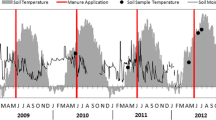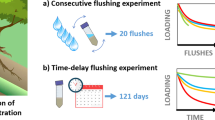Abstract
Municipal wastewater has been applied as a fertilizer to coniferous forest in northern Sweden with the additional aims to purify the wastewater and reduce the treatment costs. This practice has the potential to introduce pathogenic microorganisms from the applied wastewater or sludge to the environment, with a subsequent risk of transmission to exposed humans or animals. Seasonality and climatological conditions, in particular low temperature, humidity and low sun intensity will furthermore affect the persistence of pathogens in the forest in northern Scandinavia and may therefore enhance the survival and thereby the exposure risk. The survival of two pathogens (Salmonella senftenberg and Campylobacter coli) and four fecal indicator organisms; bacteria strains (E. coli and E. fecalis) and bacteriophages (S. typhimurium phage 28 B and ϕx174), used here as viral models, was evaluated in microcosms (60 Litre terrariums) with two vegetation regimes (characterized as moss and lichen) at selected temperatures (+3˚C to +27˚C) and artificial light exposure (light and dark). Salmonella persisted in high numbers after 35 days in the vegetation, indicating a potential risk for further transmission. Neither the vegetation regime nor temperature or light exposure as independent factors governed the reduction of the indicator bacteria and the bacteriophages. The persistence of the indicator organisms was generally best supported in the moss vegetation at low temperature in the dark, where the time for a 90% reduction (T90) was in the range from 8 days (E. coli) to 31 days (Salmonella phage). The die-off characteristics found in this study provide baseline values for further validations in the field and verify that the purification and reuse of municipal wastewater in coniferous forest could potentially be responsible for transmission of fecal pathogens to humans and animals.
Similar content being viewed by others
References
Badawy, A.S., Rose, J.B., & Gerba, C.P. (1990). Comparative survival of enteric viruses and coliphage on sewage irrigated grass. J. Environ. Sci. Health, 25, 937–952.
Baloda, S.B., Christensen, L., & Trajcevska, S. (2001). Persistence of a Salmonella enterica serovar typhimurium DT12 clone in a piggery and in agricultural soil amended with Salmonella-contaminated slurry. Appl. Environ. Microbiol., 67, 2859–2862.
Brown, K.W., Jones, S.G., & Donnelly, K.C. (1980). The influence of simulated rainfall on residual bacteria and virus on grass treated with sewage sludge. J. Environ. Qual., 9, 261–265.
Burroughs, N.J., Marsh, P., & Wellington, E.M.H. (2000). Mathematical analysis of growth and interaction dynamics of streptomycetes and a bacteriophage in soil. Appl. Environ. Microbiol., 66, 3868–3877.
Chandler, D.S., Farran, I., & Craven, J.A. (1981). Persistence and distribution of pollution indicator bacteria on land used for disposal of piggery effluent. Appl. Environ. Microbiol., 42, 453–460.
Chang, J.C., Ossoff, S.F., Lobe, D.C., Dorfman, M.H., Dumais, C.M., Qualls, R.G., & Johnson, J.D. (1985). UV inactivation of pathogenic and indicator microorganisms. Appl. Environ. Microbiol., 49, 1361–1365.
Davies, C.M., Long, J.A., Donald, M., & Ashbolt, N.J. (1995). Survival of fecal microorganisms in marine and freshwater sediments. Appl. Environ. Microbiol., 61, 1888–1896.
Duran, A.E., Muniesa, M., Mendez, X., Valero, F., Lucena, F., & Jofre, J. (2002). Removal and inactivation of indicator bacteriophages in fresh waters. J. Appl. Microbiol., 92, 338–347.
Edmonds, R.L. (1976). Survival of coliform bacteria in sewage sludge applied to a forest clearcut and potential movement into groundwater. Appl. Environ. Microbiol., 32, 537–546.
Gantzer, C., Gillerman, L., Kuznetsov, M., & Oron, G. (2001). Adsorption and survival of fecal coliforms, somatic coliphages and F-specific RNA phages in soil irrigated with wastewater. Water Sci. Technol., 43, 117–124.
Gibbs, R.A., Hu, C.J., Ho, G.E., & Unkovich, I. (1997). Regrowth of fecal coliforms and salmonellae in stored biosolids and soil amended with biosolids. Water Sci. Technol., 35, 269–275.
Guan, T.Y., & Holley, R.A. (2003). Pathogen survival in swine manure environments and transmission of human enteric illness–a review. J. Environ. Qual., 32, 383–392.
Harwood, V.J., Levine, A.D., Scott, T.M., Chivukula, V., Lukasik, J., Farrah, S.R., & Rose, J.B. (2005). Validity of the indicator organism paradigm for pathogen reduction in reclaimed water and public health protection. Appl. Environ. Microbiol., 71, 3163–3170.
Hurst, C.J., Gerba, C.P., & Cech, I. (1980). Effects of environmental variables and soil characteristics on virus survival in soil. Appl. Environ. Microbiol., 40, 1067–1079.
Islam, M., Doyle, M.P., Phatak, S.C., Millner, P., & Jiang, X. (2004). Persistence of enterohemorrhagic Escherichia coli O157:H7 in soil and on leaf lettuce and parsley grown in fields treated with contaminated manure composts or irrigation water. J. Food Prot., 67, 1365–1370.
Islam, M., Morgan, J., Doyle, M.P., Phatak, S.C., Millner, P., & Jiang, X. (2004). Fate of Salmonella enterica serovar Typhimurium on carrots and radishes grown in fields treated with contaminated manure composts or irrigation water. Appl. Environ. Microbiol., 70, 2497–2502.
Jenkins, M., Bowman, D., Fogarty, E., & Ghiorse, W. (2002). Cryptosporidium parvum oocyst inactivation in three soil types at various temperatures and water potentials. Soil Biol. Biochem., 34, 1101–1109.
Jones, K., Betaieb, M., & Telford, D.R. (1990a). Seasonal variation of thermophilic campylobacters in sewage sludge. J. Appl. Bacteriol., 69, 185–189.
Jones, K., Betaieb, M., & Telford, D.R. (1990b). Thermophilic campylobacters in surface waters around Lancaster, UK: negative correlation with Campylobacter infections in the community. J. Appl. Bacteriol., 69, 758–764.
Kudva, I.T., Blanch, K., & Hovde, C.J. (1998). Analysis of Escherichia coli O157:H7 survival in ovine or bovine manure and manure slurry. Appl. Environ. Microbiol., 64, 3166–3174.
Marsh, P., Morris, N.Z., & Wellington, E.M.H. (1998). Quantitative molecular detection of Salmonella typhimurium in soil and demonstration of persistence of an active but non-culturable population. FEMS Microbiol. Ecol., 27, 351–363.
Ng, H., Bayne, H.G., & Garibaldi, J.A. (1969). Heat resistance of Salmonella: the uniqueness of Salmonella senftenberg 775W. Appl. Microbiol., 17, 78–82.
Obiri-Danso, K., Paul, N., & Jones, K. (2001). The effects of UVB and temperature on the survival of natural populations and pure cultures of Campylobacter jejuni, Camp. coli, Camp. lari and urease-positive thermophilic campylobacters (UPTC) in surface waters. J. Appl. Microbiol., 90, 256–267.
O'Donnell, C.J., Meyer, K.B., Jones, J.V., Benton, T., Kaneshiro, E.S., Nichols, J.S., & Schaefer, F.W. (1984). Survival of parasite eggs upon storage in sludge. Appl. Environ. Microbiol., 48, 618–625.
Ogden, I.D., Hepburn, N.F., MacRae, M., Strachan, N.J., Fenlon, D.R., Rusbridge, S.M., & Pennington, T.H. (2002). Long-term survival of Escherichia coli O157 on pasture following an outbreak associated with sheep at a scout camp. Lett. Appl. Microbiol., 34, 100–104.
Ogden, L.D., Fenlon, D.R., Vinten, A.J., & Lewis, D. (2001). The fate of Escherichia coli O157 in soil and its potential to contaminate drinking water. Int. J. Food Microbiol., 66, 111–117.
Perttu, K.L. (1998). Environmental justification for short-rotation forestry in Sweden. Biomass and Bioenergy, 15, 1–6.
Perttu, K.L., & Kowalik, P.J. (1997). Salix vegetation filters for purification of waters and soils.' Biomass and Bioenergy, 12, 9–19.
Sanin, F.D., Vesilind, P.A., & Martel, C.J. (1994). Pathogen reduction capabilities of freeze/thaw sludge conditioning. Water Research, 28, 2393–2398.
Shuval, H., & Fattal, B. (2003). Control of pathogenic microorganisms in wastewater recycling and reuse in agriculture' in Mara, D. and N.J. Horan (eds.). The handbook of water and wastewater microbiology Academic Press, London, United Kingdom, pp. 241–262.
Sidhu, J., Gibbs, R.A., Ho, G.E., & Unkovich, I. (1999). Selection of Salmonella typhimurium as an indicator for pathogen regrowth potential in composted biosolids. Lett. Appl. Microbiol., 29, 303–307.
Sjogren, R.E. (1994). Prolonged survival of an environmental Escherichia coli in laboratory soil microcosms. Water Air and Soil Pollut., 75, 389–403.
Sliney, D. (1972). The merits of an envelope action spectrum for ultraviolet radiation exposure criteria. Am. Indust. Hyg. Ass. J., 33, 644–653.
Strauch, D., Konig, W., Philipp, W., & Evers, F.H. (1981). [Survival of salmonellas and Ascaris eggs during sludge utilization in forestry]. Zentralbl. Bakteriol. Mikrobiol. Hyg., [B] 174, 461– 470.
Vasseur, L., Cloutier, C., Labelle, A., Duff, J.N., Beaulieu, C., & Ansseau, C. (1996). Responses of indicator bacteria to forest soil amended with municipal sewage sludge from aerated and non-aerated ponds. Environ. Pollut., 92, 67– 72.
WHO (2004). Guidelines for drinking water quality, 3rd edition. World Health Organization, Geneva, Switzerland.
Yates, M.V., & Gerba, C.P. (1998). Microbial considerations in wastewater reclamation and reuse' in T. Asano (ed.). Wastewater reclamation and reuse Technomic publishing co. inc., Lancaster, USA, pp. 427–488.
Author information
Authors and Affiliations
Corresponding author
Rights and permissions
About this article
Cite this article
Åström, J., Carlander, A., Sahlén, K. et al. Fecal Indicator and Pathogen Reduction in Vegetation Microcosms. Water Air Soil Pollut 176, 375–387 (2006). https://doi.org/10.1007/s11270-006-9173-3
Received:
Accepted:
Published:
Issue Date:
DOI: https://doi.org/10.1007/s11270-006-9173-3




